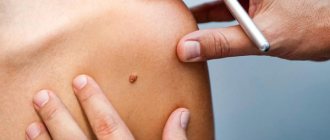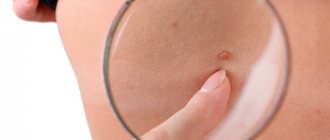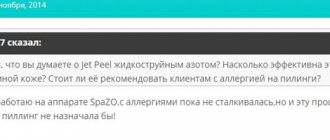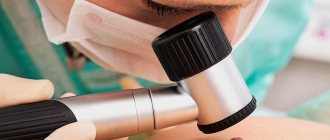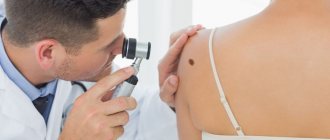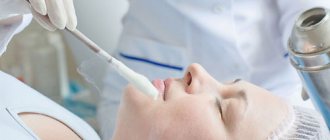Author
Kulova Zhanna Borisovna
Head of the Center for Cosmetology and Preventive Medicine
Cosmetologist
until January 31
You get 10% cashback when purchasing a gift certificate More details All promotions
Cryodestruction is a method of removing tumors on the skin, which is based on the use of liquid nitrogen. Often considered as a tool in aesthetic cosmetology and dermatology, allowing you to get rid of:
- warts;
- papillomas;
- condylomas;
- keratome;
- hemangiomas;
- unwanted moles (nevi).
This method is successfully used in other branches of medicine - gynecology, surgery, oncology. The method of cryodestruction successfully removes tonsils and treats cervical erosion. Using endoscopic methods, doctors have learned to use cryodestruction to combat tumors of internal organs.
Removal of tumors with liquid nitrogen: main advantages
The main advantage of this method is its low invasiveness. After the destruction of the tumor, a crust forms on the skin, under which the healing process is actively underway. Soon the crust falls off, leaving no trace. There is practically no bleeding or pain during this procedure; there is no need for special preparation or anesthesia.
The benefits of using liquid nitrogen include:
- rapidity;
- short recovery period;
- no need for special care of the treated skin area;
- affordable prices for cryodestruction procedures.
It is also important that various moles, papillomas or warts, regardless of their nature, can be treated equally effectively. Therefore, if you decide to remove a skin tumor by cryodestruction, you can count on a positive result after the first session.
What to do after removing a wart with liquid nitrogen
The final result after wart removal largely depends on how well the subsequent care was organized. After all, the skin receives quite serious damage during treatment with liquid nitrogen. To ensure the best healing, you need to follow these recommendations:
- After a blister appears, it must be carefully protected from damage and under no circumstances should it be punctured. If warts were removed in areas of possible rubbing with clothing, then any contact with the blisters should be avoided. If their integrity is violated, there is a high probability of infection, suppuration, and the formation of scars.
- Twice a day, blisters are treated with a solution of salicylic alcohol (2%) or potassium permanganate. This speeds up the crust formation process and provides additional protection against infections.
- It is forbidden to cover blisters with adhesive tape, as they may stick to them and cause damage. If there is a need to cover them, then you need to use loose gauze bandages or secure special gauze napkins with a band-aid, but on healthy skin.
- Blisters can be soaked with water, i.e. Showering is allowed. But you can’t rub them with a sponge or towel (just blot them gently).
- To care for blisters, scabs and skin, you should use only those products prescribed by your dermatologist. Self-medication is unacceptable.
- If severe pain occurs after the removal procedure, you can take painkillers.
If any changes are noticed on the skin that the doctor did not warn about, then you should definitely contact him for help. Usually, removing warts with nitrogen does not cause complications, but the treated areas must be carefully looked after.
How is papillomas removed by cryodestruction?
A few seconds of exposure to liquid nitrogen is enough for the neoplasm to collapse
Using the example of papilloma, we will look at how the procedure for removing a tumor with liquid nitrogen is carried out. The process can be divided into the following stages:
1. Freezing papilloma. Using a special device or miniature applicator, the doctor applies liquid nitrogen with a temperature of –195.7 degrees Celsius to the tumor.
2. Necrosis of papilloma. Under the influence of liquid nitrogen, the pathological area turns pale, the patient begins to feel a slight tingling: this is the crystallization of the cytoplasm in the neoplasm cells, which damages their membranes. The time allotted for the procedure (from 5 to 30 seconds) is quite enough to cause irreparable damage to the papilloma.
3. Restoration of blood circulation. Within a few hours after the procedure, the area of skin where the papilloma was located turns red and swells.
4. Complete necrosis of papilloma. The process takes from 2 weeks to 2 months. From the neoplasm itself, only a crust remains, and healthy, smooth tissue forms under it.
5. Recovery. After a maximum of six months, there will be no traces left on the skin.
If the papilloma was large enough, the procedure may need to be repeated. In this case, only a doctor can give the exact timing of the final solution to the problem.
If after cryotherapy a bubble with liquid appears at the site of the tumor, it is not recommended to pierce it. It is better to treat the skin area with an antiseptic until this bubble disappears naturally, or consult a dermatologist for advice.
Removal of papillomas with liquid nitrogen in Moscow: features of the technique
Cryodestruction is the removal of skin lesions using liquid nitrogen. Why do we use this particular method? The fact is that nitrogen is a component of atmospheric air. In order to remove papillomas using cryodestruction, it is necessary to obtain liquid. Nitrogen changes from gaseous to liquid at a temperature of 200C. The technological process is quite simple and proven: nitrogen needs to be cooled, converted into a liquid state, in which the substance is poured into flasks and stored under certain conditions.
Indications and contraindications for cryodestruction
As a rule, patients decide to remove skin tumors wanting to get rid of cosmetic defects. First of all, it is recommended to remove moles and warts located in “unsuccessful” areas where they are regularly injured.
There are practically no contraindications to cryotherapy: it is recommended even for children, if necessary. But there are cases when it does not give the desired effect, for example, if the diameter of the tumor exceeds 4 mm.
It is better to refrain from cryodestruction during infectious and inflammatory processes until they are cured.
Make an appointment Do not self-medicate. Contact our specialists who will correctly diagnose and prescribe treatment.
Cost of the procedure
The cost of removing warts with liquid nitrogen is determined by the number of growths on the skin. Sometimes it is necessary to conduct several cryodestruction sessions, which increases the total cost of treatment.
At the Healthy Family clinic, you can remove warts with liquid nitrogen in Moscow. Experienced specialists work with patients, observing infection safety rules. We provide comprehensive and consistently high-quality medical care.
See also:
Cryodestruction
Facial cryomassage
Cryodestruction of tonsils
Types of warts
Depending on the location and appearance, warts can be flat, vulgar and plantar.
Flat warts
often multiple, have the color of the surrounding skin and are small in size (no more than 5 mm), painless, surface roughness is insignificant or absent. The most common location of flat warts is the skin of the face.
Vulgar warts
larger ones (from 2 mm to 10 mm), located singly and in groups, protrude above the surface of the skin, have a pronounced rough surface, the color matches the color of the surrounding skin, sometimes they can have a yellowish, grayish or pink tint. In some cases, “black dots” are visible on the surface of a vulgar wart - this is the result of thrombosis of small capillaries feeding the neoplasm. Vulgar warts can be located in any part of the skin, but more often on the hands.
Plantar warts
localized on the skin of the soles, due to pressure when walking, they grow inward, causing pain and discomfort. They can reach large sizes (up to 15–20 mm in diameter), the color is often yellowish. The characteristic differences between a plantar wart and a callus of the sole are a violation of the skin pattern of the sole and pain with lateral compression.
There is the ability for warts to resolve on their own as a result of the development of immunity to the human papillomavirus, but this is not so common. If warts last for a long time, they can spread through contact by rubbing the skin, as well as transmitting the virus to family members or organized groups.
The main way to treat warts is removal. Methods such as surgical, radio wave, laser, electrocoagulation, chemical destruction and cryodestruction are used.
What are the most common warts?
Most often (up to 70% of all cases), patients report warts that bother them, and the majority of patients are school-age children. Warts are also found in 20% of students. Plantar warts are more common in adults (34% of cases), as opposed to flat warts, which are again more common in children (4% of all warts).
An experienced dermatologist can easily determine the type of wart during a consultation. However, in rare cases, especially if the wart is injured, it is difficult to diagnose it only by examination, and then the doctor can perform a biopsy of the derivative and histological examination.
3.How does it work and what are the risks?
How it works?
Cryotherapy will help remove warts, but the virus itself may remain, so additional treatments may be required.
What are the risks of cryotherapy?
If the wart is thick and requires extensive cryotherapy, the nerves around it may be damaged, scar tissue may form, and healing may take longer.
There is a small chance of infection during wart removal with nitrogen. Signs of infection include:
- Increased pain, redness, swelling;
- Purulent discharge;
- Heat.
About our clinic Chistye Prudy metro station Medintercom page!
Consequences of cryodestruction
If you follow the cryodestruction technique, carefully prepare the patient for the procedure and assess the possible consequences, the risk of complications is minimal. Contact of skin with liquid nitrogen causes instant freezing and whitening of tissues. The body's natural reaction to cryotherapy is the appearance of a blister with clear fluid and a local inflammatory reaction. Tissue swelling will persist for a week. Moderate pain may occur. After some time, the treated skin becomes covered with a crust that cannot be peeled off. Otherwise, complications may occur in the form of scars, bleeding, suppuration and secondary infection.
Follow the recommendations of the specialist who performs cryodestruction. This will help avoid adverse health effects. It is recommended to limit skin contact with decorative cosmetics, ultraviolet radiation, and avoid visiting bathhouses, saunas, and public swimming pools. These actions will help prevent potentially dangerous viruses and bacteria from coming into contact with inflamed skin and spreading the infectious and inflammatory process.
Comparison of wart removal methods: laser and nitrogen
Most patients are interested in which of the listed methods is most effective. Most often they choose between laser and liquid nitrogen. Each of these technologies has its own advantages. For a laser it is:
- high efficiency,
- speed,
- painlessness,
- no postoperative bleeding.
In addition, the laser allows the surgeon to act in a targeted manner, avoiding nearby healthy tissue. At the same time, he directs a heat beam at the wart, which evaporates the moisture contained in the growth and destroys its structure. Due to the lack of contact with the skin, wound infection during the procedure is completely excluded.
When choosing cryodestruction technology, you should be prepared for the fact that 3-5 procedures will be required to completely remove the tumor. This is due to the fact that the method involves layer-by-layer exposure of pathological tissues to low temperature. If the growth is small, then one treatment is sufficient to freeze and kill it.
Another selection criterion is the cost of therapy. Removing papilloma using cryodestruction is relatively cheap, but the more procedures are required, the more expensive such treatment will ultimately cost. In addition, when exposed to liquid nitrogen, there is a small risk of damage to healthy tissue, and hence the appearance of a scar.
Only a doctor can determine which of the listed methods will be most effective. But to come to a final decision, he must collect anamnesis, conduct an examination of the patient and send pathological tissues for histology.
How should a patient behave after cryodestruction?
After completing the procedure, it is important:
- when forming a bubble, try not to injure it, do not rub, do not scratch;
- in case of accidental trauma to the bladder, treat the lesion with solutions of aniline dyes (fucorcin, methylene blue) or a strong solution of manganese to prevent secondary infection;
- disinfect household items (washcloths, towels, shoes, manicure and pedicure tools);
- maintain hygiene of clothing and footwear;
- if there is redness, pain, discharge from the lesion, consult a specialist.
